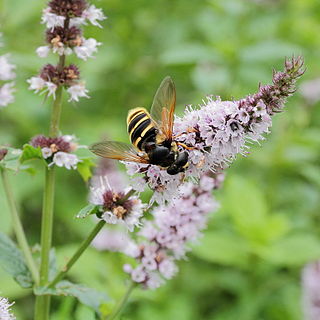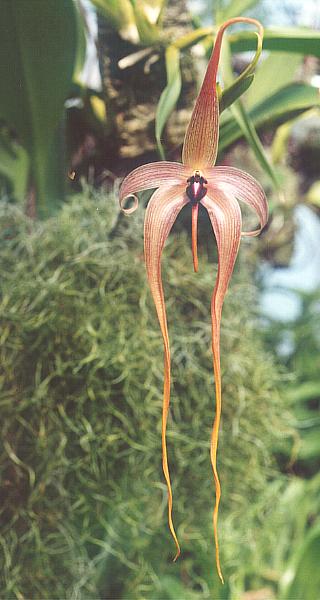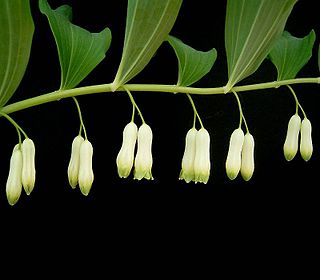
Mentha is a genus of plants in the family Lamiaceae. The exact distinction between species is unclear; it is estimated that 13 to 24 species exist. Hybridization occurs naturally where some species' ranges overlap. Many hybrids and cultivars are known.

Bulbophyllum is a genus of mostly epiphytic and lithophytic orchids in the family Orchidaceae. It is the largest genus in the orchid family and one of the largest genera of flowering plants with more than 2,000 species, exceeded in number only by Astragalus. These orchids are found in diverse habitats throughout most of the warmer parts of the world including Africa, southern Asia, Latin America, the West Indies, and various islands in the Indian and Pacific Oceans. Orchids in this genus have thread-like or fibrous roots that creep over the surface of trees or rocks or hang from branches. The stem is divided into a rhizome and a pseudobulb, a feature that distinguished this genus from Dendrobium. There is usually only a single leaf at the top of the pseudobulb and from one to many flowers are arranged along an unbranched flowering stem that arises from the base of the pseudobulb. Several attempts have been made to separate Bulbophyllum into smaller genera, but most have not been accepted by the World Checklist of Selected Plant Families.

Crambe is a genus of annual and perennial flowering plants in the family Brassicaceae, native to a variety of habitats in Europe, Turkey, southwest and central Asia and eastern Africa. They carry dense racemes of tiny white or yellow flowers on stems above the basal leaves. Crambe hispanica subsp. abyssinica, formerly known as Crambe abyssinica, is grown for the oil from the seeds that has characteristics similar to whale oil.

The genus Pulsatilla contains about 40 species of herbaceous perennial plants native to meadows and prairies of North America, Europe, and Asia. Derived from the Hebrew word for Passover, "pasakh", the common name pasque flower refers to the Easter (Passover) flowering period, in the spring. Common names include pasque flower, wind flower, prairie crocus, Easter flower, and meadow anemone. Several species are valued ornamentals because of their finely-dissected leaves, solitary bell-shaped flowers, and plumed seed heads. The showy part of the flower consists of sepals, not petals.

Joseph Marie Henry Alfred Perrier de la Bâthie was a French botanist who specialized in the plants of Madagascar.

Polygonatum, also known as King Solomon's-seal or Solomon's seal, is a genus of flowering plants. In the APG III classification system, it is placed in the family Asparagaceae, subfamily Nolinoideae. It has also been classified in the former family Convallariaceae and, like many lilioid monocots, was formerly classified in the lily family, Liliaceae. The genus is distributed throughout the temperate Northern Hemisphere. Most of the approximately 63 species occur in Asia, with 20 endemic to China.

Isatis is a genus of flowering plants in the family Brassicaceae, native to the Mediterranean region east to central Asia. Its genus name, Isatis, derives from the ancient Greek word for the plant, ἰσάτις. The genus includes woad. Due to their extremely variable morphology, the Asian species in particular are difficult to determine; the only reliable diagnostic feature is the ripe fruit. They are (usually) biennial or perennial herbaceous plants, often bluish and hairless or downy hairy with the upright stem branched.

Jacobaea is a genus of flowering plants in the tribe Senecioneae and the family Asteraceae. Its members used to be placed in the genus Senecio, but have been separated into the segregate genus Jacobaea on the basis of molecular phylogenetics in order to maintain genera that are monophyletic.

Anemonoides is a genus of flowering plants in the buttercup family Ranunculaceae. Plants of the genus are native to the temperate regions of the Northern Hemisphere, on the continents of North America, Europe, and Asia. The generic name Anemonoides means "anemone-like", a reminder that many of the species were formerly included within the genus Anemone.
Knorringia is a genus of plants in the family Polygonaceae. It is native to Central Asia and Siberia.

Nymphaea candida J. Presl is a species of flowering plant in the genus Nymphaea, native to quiet freshwater habitats in Eurasia, it is in flower from July to August. It is sometimes treated as a subspecies of N. alba
Littledalea is a genus of Asian plants in the grass family, native to mountains in China and neighboring countries. The genus is placed in its own tribe Littledaleae within subfamily Pooideae. The isolated tribe seems to be sister to the tribes Bromeae and Triticeae.

Chesneya is a genus of flowering plants in the legume family, Fabaceae. It includes 47 species which range across temperate Asia, from Turkey through Syria, Iraq, Iran, Central Asia, and the Himalayas to Inner Mongolia, central China, and Myanmar. It belongs to the subfamily Faboideae.

Aaron Thomas Korsh is an American television producer, writer, and former investment banker.

The World Checklist of Selected Plant Families was an "international collaborative programme that provides the latest peer reviewed and published opinions on the accepted scientific names and synonyms of selected plant families." Maintained by the Royal Botanic Gardens, Kew, it was available online, allowing searches for the names of families, genera and species, as well as the ability to create checklists.

The Russian Drama Korsh Theatre, commonly known as the Korsh Theatre, was a theatre which functioned in Moscow, Imperial Russia from 1882 until 1917. It was named after its founder, entrepreneur Fyodor Korsh.

Parrya is a genus of flowering plants in the family Brassicaceae, found in the arctic and subarctic biomes of the Northern Hemisphere, and in Central Asia. The center of diversity is the Tian Shan and Pamir-Alay mountain ranges.
Calymmatium is a genus of flowering plants belonging to the family Brassicaceae.

Clematis tangutica, the golden clematis, is a species of flowering plant in the family Ranunculaceae. It is found from Central Asia through to most of China, and it has been introduced to western Canada, Czechia, Slovakia, Switzerland, and the South Island of New Zealand. Its cultivars 'Bill MacKenzie' and 'Lambton Park', both members of the Tangutica Group, have gained the Royal Horticultural Society's Award of Garden Merit.

Petrosimonia is a genus of flowering plants belonging to the family Amaranthaceae. It is also in the Salsoloideae tribe.

















